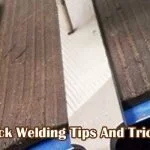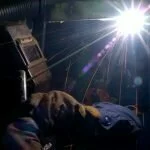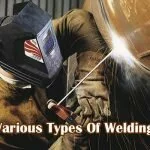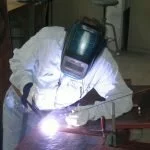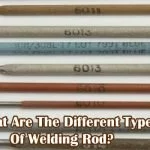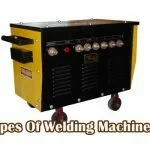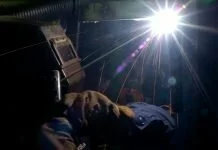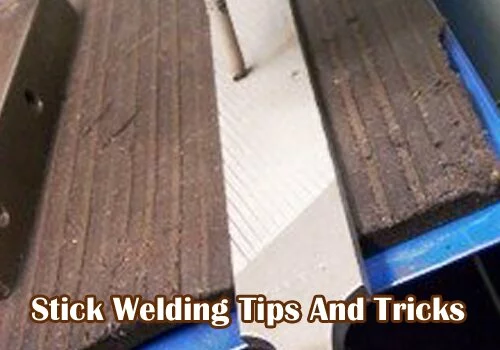What is stick welding? Another name for Covered Electrode or Shielded Metal Arc Welding or SMAW, stick welding is the most commonly used arc welding process. It uses an electrode of fixed length, and is powered by an electricity source to join various types of metals. The covered electrode’s core is made up of a solid metal enclosed by mineral compounds and a mix of metal powders and a type of binding agent that helps the material to stick to the electrode’s surface.
In this article you will know:
What is stick welding and its characteristics
The core rod provides the filler metal used for the joint and conducts electricity to the arc. The type of electrode and the size used for stick welding determine the arc voltage (which ranges between 16 and 40 volts) as well as the amperage (which ranges between 20 and 550 amperes) requirements. Depending on the type of electrode used, the current may either be direct or alternating. The power source, however, must be capable of controlling the current level within an acceptable range to address the complex variables inherent to the welding process.
The electrode covering primarily works to provide stability to the arc and to shield and protect the molten metal from the gases in the atmosphere released as the coating is decomposed due to the heat coming from the arc. It helps control the chemical composition, metallurgical structure, and mechanical properties of the weld metal, and the electrode’s arch characteristics. The electrode covering, on the other hand, is composed of materials determined by the type of electrode used.
What Is Stick Welding and Its Characteristics?
- A very versatile process in terms of environment and location of operation, stick welding may be performed indoors, outdoors, in a production line, a bridge, a ship, a cross country pipeline, and oil refinery, and other similar locations. Water and gas hoses are not required, although diesel or gasoline powered units may be used in remote areas. Welding cables typically extend beyond the power source significantly.
- There is no need for granular flux or gas shielding.
- The equipment is inexpensive, portable, and relatively simple.
- The welding process is not as wind and draft-sensitive as the gas-shielded arc types of welding processes.
- The welding process can be utilized in limited-access areas.
- Stick welding is appropriate for majority of the commonly used alloys and metals.
What Are Stick Welding Limitations
- The duty cycles of operators are lower when compared with automatic and semi-automatic processes. This results to a higher cost per pound of stick welding joined metal.
- The deposition rates are lower in general, compared to other welding processes.
- Because the process cannot be easily mechanized, it is considered manual.
- The welding process is not appropriate for use with reactive metals like zirconium, titanium, columbium, and tantalum because the shielding is not capable of preventing weld contamination from oxygen.
Practical Stick Welding Tips & Tricks
While stick welding may be the most prevalent type of arc welding, creating good welds may not necessarily be easy, especially for beginners. Stick welding, unlike “point and shoot” types of welding, requires a higher level of skills and mastery of some techniques.
Following are some tips and tricks that can help you improve your chances of coming up with high quality stick welds:
- Choose steel within the normal range. – As much as possible choose AISI-SAE 1015-1025 steels with 0.1% max silicon and 0.35 sulphur content. This way, you are guaranteed to weld at faster speeds with less tendencies to crack.
- Choose an appropriate joint position and electrode for the metal. – The joint position can considerably affect the quality of the finished weld. If you are welding on 10 – 18 gauge metal sheets, you can achieve the best speeds working on a 45 – 75o downhill angle. Likewise, avoid over-welding or making a weld that is bigger than necessary for joint stability and strength as this may result to burn-through. On the other hand, position the work-piece flat when welding steel plates that are at least 3/16” thick.
- Follow the simple joint geometry and fit-up principles. – Joint dimensions are selected for good weld quality as well as for fast welding speeds. On the other hand, sound joint geometry is contingent on the following principles:
- The fit-up should be consistent throughout the whole joint.
- Sufficient bevel is necessary for superior bead shape and penetration.
- Enough root opening is required to achieve full penetration, while undue root openings waste weld metals and considerably slows the welding speed.
- A backup strip or root face is necessary for faster and good quality welding.
- Generally, weld seal beads worked on flat do well with 3/16” AWS E6010 at around 150 amperes DC+. It is recommended to use 1/8” at about 90 amperes DC+ for overhead, vertical and horizontal butt welds. In case of lower hydrogen and seal beads, it is recommended to weld using an AWS EXX18 electrode at around 170 amperes.
- Avoid over-welding and build-up. – Fillets must have equal legs and an almost flat bead surface. Except in rare cases, build-up must exceed 1/16”. Undue build-up may prove costly in terms of time and materials, does not help in weld strength, and results to an increase in distortion. Doubling the fillet size, for instance, need 4 times more weld metals. Likewise, it would cost 2/3 more for butt welding just one single-V that has 1/8” land and a root opening of 1/32” if the excess build-up comes close to 1/8”.
- Clean up the joint prior to welding. – To achieve the desired weld travel speed and avoid porosity, it is crucial to get rid of excessive rust, scale, paint, moisture, grease, and oil from the joint surface. If this is not possible, use Fleetweld 5P (AWS E6010) or Fleetweld 180 or Fleetweld 35 (AWS E6011) electrodes so penetration through the contaminants and deep into the base metal would be possible. The travel speed must be slowed down to give gas bubbles sufficient time to boil molten weld out before it freezes.
- Select the Right-Sized Electrode. – Larger electrodes weld at higher currents at higher deposit rates. Thus, it is best to use the largest electrode size possible to guaranty good weld quality. However, the electrode size might be limited, particularly on sheet metals and root passes that may allow burn-through to happen. In general, 3/16” should be the maximum practical size for overhead and vertical welding, while the maximum practical size for low hydrogen should be 5/32”. Moreover, joint dimensions may sometimes limit the diameter of the electrode that can fit into the joint.
